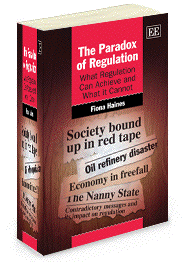
Regulatory success depends on managing actuarial, socio-cultural, and political risk.
Regulation inhabits contested political terrain. Politicians generate regulations in response to crises ranging from industrial disasters to financial collapses. Business rails against bureaucratic red tape while critics of government bemoan the lost economic opportunities regulation causes. Government responds with multiple attempts to reduce, clarify, or streamline regulatory demands on business. These competing pressures have resulted in the never-ending cycle of regulation and deregulation long lamented by commentators.
 Many point to science and expertise as the foundation of good regulation and the means to break this cycle. Expert analysis of risk and optimal forms of risk management are understood as the keys to generating, in Alfred E. Kahn’s words, a regulatory spiral and overall progressive reform rather than a cyclical repeat of history. In this view, well-crafted and discretely targeted regulation is seen as the way to reduce a particular risk while allowing broader benefits to remain.
Many point to science and expertise as the foundation of good regulation and the means to break this cycle. Expert analysis of risk and optimal forms of risk management are understood as the keys to generating, in Alfred E. Kahn’s words, a regulatory spiral and overall progressive reform rather than a cyclical repeat of history. In this view, well-crafted and discretely targeted regulation is seen as the way to reduce a particular risk while allowing broader benefits to remain.However, despite the siren call for expertise, regulation remains stubbornly political. Obviously, regulation’s role in signalling value choices that determine who bears particular risks and who and what will be protected makes it political. The act of regulating, as Cass Sunstein has noted, places a priority on one form of harm while raising the likelihood of a negative consequence elsewhere. However, as I argue in The Paradox of Regulation: What Regulation Can Achieve and What It Cannot, regulatory reform as much about the reduction of political risk as it is about preventing the next industrial disaster or financial crisis. Likewise, governments use deregulation to demonstrate their responsiveness to business demands. The political character to regulation does not diminish as experts assert control. After all, regulation does not emerge from a laboratory, but instead through multiple political and bureaucratic processes—it is both a human and a technical process.
We need to reassess the question of what risks lie at the heart of regulation. In my book,I argue that three distinct, ideal-typical forms of risk accompany regulation. The first, actuarial risk, is indeed technical. The second, socio-cultural risk, is concerned with social solidarity, social order, identity and belonging. The final, political risk, involves dangers to political legitimacy. Regulators must successfully manage each one of these risks for regulatory success.
“Actuarial risk” is most obviously associated with a regulatory regime. The actuarial risk of an oil spill, a workplace death, a financial collapse, or a terrorist attack on critical infrastructure has led to significant reforms over recent decades. These risks are subject to expert analyses, assessments of the severity of their impact, the likelihood of their occurrence, and the capacity and means for their management. Further bureaucratic and expert assessments, such as cost-benefit analysis and regulatory review, determine which controls are needed.
Socio-cultural risk is an inevitable consequence of our nature as social beings. Our destiny is to live interdependent lives inextricably interwoven with the health, norms, and values of our society—and its expectations both of us and for us. Threats to collective norms raise anxiety and demands for security.
Managing political risk involves a paradox. Actuarial risk, although the most prominent in public debate on the need for regulation, is actually the most expendable in the struggle to manage political risk. Regimes ineffective at managing actuarial risk can still manage political risk, and even enhance legitimacy, through regulatory intervention. Understanding this trade-off requires an appreciation of the particular challenge the management of political risk poses to government: it requires the control of two often-competing elements—socio-cultural and economic—to retain political legitimacy. Providing reassurance by promising security is the concern of the socio-cultural element, while the economic element arises from the need of government to nurture conditions conducive to a vibrant economy.
A disaster or crisis raises the stakes associated with each of these forms of risk. Regulation is seen as a way to manage not just actuarial risk, but also political and socio-cultural risk. The regulatory reform process brings political risk to the forefront.
An example from Australia powerfully captures this observation. In response to an industrial disaster, a gas explosion in Victoria, Australia, that killed two and left the state without gas for two weeks, the state governments of Victoria and New South Wales took two different approaches on managing actuarial, socio-economic, and political risk.
In Victoria, the first response, an industrial manslaughter bill, failed to gain the necessary parliamentary support. The prospect of a tight election saw the incumbent government respond to business demands to drop their industrial manslaughter initiative. However, continued high public anxiety about a repeat disaster posed political risk. Politicians then turned to technical experts to develop a regulatory regime—an enhanced safety case model—capable of reducing the risk of another explosion. The Victorian government was able to control actuarial risk, together with political and socio-cultural risk.
By contrast, in New South Wales, reform was painfully slower than that of Victoria despite a number of equally hazardous factories located within the state capital, Sydney. Yet, economic concerns and public reassurance in New South Wales could be met without tackling regulatory reform in the area of industrial hazards.
I have empirically observed this pattern of political risk management shaping regulatory outcomes, frequently – but not always – to the detriment of actuarial risk, in corporate law reform, insurance law, and counterterrorism security at sea and airports as well as in responses to industrial disasters.
While knowledge of particular actuarial risks varies, considerable progress has been made in developing effective controls to manage these types of risk. Yet our understanding of how to manage both political and socio-cultural risk remains in its infancy. This inadequacy exists despite the fact that both types of risk are equally, if not more, important to regulatory success than actuarial risk. Without improved understanding of political and socio-cultural risks, their character and the ways to manage them, the oft-heard promise that follows disaster—”Never again!”—may likely continue to remain hollow.




